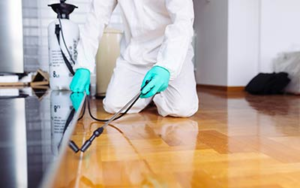Pest control involves preventing or reducing the number of unwanted organisms to an acceptable level. It also consists of doing this with as little harm to everything else as possible. Contact South Shore IPM now!
Weather conditions – temperature, day length, and humidity – affect pest activity. Water supplies and shelters can also limit the number of pests.

Insects are the most common animals on Earth. They buzz, scuttle and flit in every ecosystem, providing food for a wide range of other species and performing essential functions such as recycling nutrients, pollinating flowers and crops, and controlling pests. But insects are not just any old creepy-crawlies: The term “insect” refers to a specific group of animals within the phylum Arthropoda — the critters that also include crustaceans, arachnids (spiders, scorpions) and myriapods (millipedes, centipedes). The key distinction is that insects have a chitinous exoskeleton, three body segments and six legs.
It’s estimated that there are 10 quintillion insects alive at any one time, more than a billion for every person on the planet. Many of these insects are beneficial, such as dung beetles that aerate and bury animal waste, keeping it out of landfills; or ladybugs that devour harmful aphids and other aphid predators. Others, like the infamous drugstore beetle that tunnels its way into books and leaves behind a powdery residue, are considered pests.
When insect populations get out of control, biological controls such as the mass-production and release of the pest’s natural enemies can help keep them in check. Such methods require extensive research into the biology of the pest and its natural enemies, including a careful consideration of the potential for unintended consequences on native species that are not pests. Once suitable natural enemies are identified, they undergo a lengthy quarantine period to ensure that they are disease-free and can be safely released.
For example, the Cornell AES professional greenhouse staff have been using biocontrols — the term for actively encouraging one living thing to control another problematic living thing — for 20 years in their conservatory, which is open to the public. While they still use pesticides, the biocontrols allow them to minimize chemicals and keep their plants healthy.
The same approach can be used in the home garden, with a little patience. For instance, a new product based on the bacteria Bacillus thuringiensis, or Bt, can be applied to a lawn or garden to kill caterpillars and other insects by blocking their gut with a protein that they cannot produce themselves.
Rodents
Rodents (including rats, mice, squirrels, shrews and gophers) are the most common pests in homes and businesses. They carry diseases that put people at risk, including Lymphocytic Choriomeningitis (LCM), Salmonella, Leptospirosis and other bacteria and parasites. They contaminate food and cause damage to property.
Rodents are opportunistic feeders and can survive on a wide range of foods, including fruits, vegetables, grain, meat, pet food and even trash. When they invade a building, they will look for sources of water and shelter. They can also gnaw holes in walls and floors, dislodging insulation and harming weather-proofing products. In addition, they are known to chew through wires which can lead to fire hazards and damage structures like ice cube machines, garbage disposal units, HVAC systems and kitchen appliances.
Regular inspections and simple preventive measures can help reduce rodent infestations and associated pest control issues. Store foods in secure containers, keep spills and crumbs cleaned up and patch or seal entry points. Install door sweeps, close gaps around pipes and vents and eliminate gaps at utility lines and boxes. Keep garbage and compost piles tightly closed and turn them regularly to avoid attracting rodents.
Clutter and bare trees, shrubs, flower beds, and ground cover attract rodents by offering shelter and hiding spots. Keep landscaping trimmed and avoid allowing tree limbs to touch a building facade.
Gnawing and burrowing activities by rodents can disturb soil, ruins plants, and undermine buildings, sidewalks and roads. They can also be a significant threat to livestock and crops.
Rodent populations vary seasonally and by habitat and can be hard to predict, requiring an ecologically based approach to control (EBRM). This approach is designed around rodent population dynamics, environmental factors, and local sociocultural conditions.
EBRM uses low hazard rodenticides, traps and/or bait stations. These are integrated with sanitation, habitat modification, and education to control rodents and their associated problems. It’s critical to work with a pest management company that has experience with this type of approach. Alta Pest Control offers comprehensive rodent control programs that provide peace of mind and long term success.
Pathogens
Pathogens are microorganisms that can cause diseases in their host. They include bacteria, viruses, fungi and protozoans. Diseases caused by these organisms are called infectious diseases.
Pathogens can affect plants, animals and people. They can spread from person to person through skin contact, airborne particles or through fecal contact with the body’s waste products (including soiled diapers and clothing). These pathogens can enter the body through these channels because they can evade the body’s immune system.
Once pathogens enter the host body, they release toxins that destroy or disable tissues and organs. These toxins also interfere with the host’s ability to use its energy and nutrients. Infections can range in severity from the common cold to lethal diseases such as cholera and AIDS.
Some pathogens have narrow host ranges, infecting only one or a few species. The bacterium that causes late blight in tomatoes and potatoes is an example of a pathogen with a narrow host plant range. Other pathogens have broad host ranges, infecting many different species of plants and crops. For example, Yersinia pestis, the agent of bubonic plague, is an intracellular obligate bacterium that lives in fleas and can be passed to humans through flea bites.
Generally, host-specific pathogens do not harm healthy individuals. However, they can seriously impede the performance and quality of crops. For example, plant pathogens often manipulate hormone pathways that regulate photosynthesis and flowering. The result is reduced plant fitness and lowered crop yields. Fortunately, there are ways to prevent the spread of pathogens, such as getting vaccinations, practicing hand hygiene and using good food handling and preparation practices. This is particularly important in healthcare settings, where pathogens can evade infection control measures and infect patients.
Clutter
Clutter provides all sorts of nooks and crannies for pests to hide in, and this is particularly true of rodents. Rodents like mice and rats are known to build nests in cluttered areas, where they can stay safe from predators and easily access food. They can also avoid detection by people and other animals, which makes them harder to catch and remove from a property. In fact, research by the Boston Housing Authority (BHA) found that tenants with hoarding tendencies required twice as many pest control visits than those who didn’t.
It’s worth pointing out that clutter doesn’t always contain food for pests. However, it can offer other benefits that attract them. For example, some pests, such as cockroaches and spiders, seek shelter in cluttered spaces, and these places may provide the ideal temperature for them to thrive in. In addition, some pests feed on discarded paper and cardboard, so a stack of old newspapers or boxes lying around can provide them with an easy-to-access meal.
From a pest management perspective, excessive clutter also makes it more difficult to address and eradicate infestations. It can obstruct the process of sealing entry points, making it more challenging for both pest control professionals and homeowners to inspect and treat a property. This can lead to delays in addressing pest issues, which can exacerbate the problems they cause.
Regularly decluttering, using bins with tight-fitting lids, storing food in containers that seal, fixing leaks and other preventive measures will help to reduce the risk of pest infestation. It is also important to keep outdoor areas, such as garden sheds, free from excessive clutter, which can provide shelter for pests and block entry points. In addition, using baits or sprays to prevent and eradicate pests is much more effective when a home has been properly cleaned and maintained. If you have pest problems, it’s best to contact a pest control specialist for expert advice and treatment. However, you can limit the impact of a pest infestation by limiting indoor and outdoor clutter, conducting regular maintenance, sanitising, sealing cracks and gaps, storing food in sealed containers, using dehumidifiers to minimise moisture levels and undertaking regular professional inspections.




